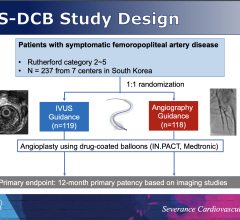
An example of the new generation of inexpensive, wearable cardiac monitors that are seeing increased usage. This is the Cardiac Insight Cardea Solo device. After the monitoring period is over, the wearable patch is torn open to retrieve a data pod that is inserted into a reader to download the data. The software automatically creates reports based on the data, complete with waveforms for various cardiac measures.
The show floors at the American College of Cardiology (ACC) 2018 meeting in March and at the Heart Rhythm Society (HRS) included numerous vendors offering small, easy-to-use, inexpensive, leadless wearable cardiac monitors. These are being offered as replacements for bulky, expensive Holter monitors or event monitors that patients wear on their belt and require wire leads to be attached to several points on their bodies. These new wearable monitors can record long periods of cardiac activity, and usually have a button for patients to use when they want to flag an event. They can be worn in the shower and while sleeping, and offer many practical advantages over the older standard event monitoring technologies.
I have seen these devices gaining ground over the past few years at both ACC and HRS meetings and predict they will become the monitoring technology of choice in the future. Unlike traditional Holter and cardiac event recorders, this new generation of devices is inexpensive or even disposable, and are much easier to use. They eliminate electrode wires and the devices are simply stuck on the patient's chest. In some devices, the monitoring capsule inside the wearable can be retrieved to download patient data using a reader device. In other devices, they interface wirelessly with a cellular-enabled device to send data remotely using a base unit interface with cell phones. These devices also enable longer-term monitoring, which will offer more data on the patient to aid in diagnoses, especially in patients with transient cardiac events.
I spoke with one of the wearable patient monitor companies at ACC 2018, Cardiac Insight. The vendor offers the ability for practices to take ownership of their own monitoring services and reports instead of outsourcing it to a third party. I included a segment on how the device works in the VIDEO Editor's Choice of Most Innovative New Cardiac Technology at ACC 2018. For additional examples of the newer wearable ECG monitoring systems, watch the VIDEOS "Editor's Choice of Most Innovative New Technology at HRS 2017," and "ACC 2014 Editor's Choice of Most Innovative New Technologies."
The movement toward easier-to-use Holter technology and smartphones was recently embraced by GE Healthcare, with the introduction of its Seer 1000 system. This hip, app-driven Holter recorder uses an app to help guide the user and the clinician through proper set up and then interfaces with iPhones, iPads or Bluetooth enabled PCs to remotely transmit patient data. It has a smaller, sleek profile in comparison to traditional Holters, and has the simplified look of the new wearable cardiac monitors with only a single button for the patient to press to flag cardiac events.
The newer generation of devices has also brought with it a rapid expansion in the amount of data recorded. While event recorders generally only record events when the device is triggered by the patient and Holters only record one or two days of data, some of the newer clinical grade systems record all ECG data 24/7 for days or weeks. Some allow for immediate analysis of that data using automated algorithms. One of these technologies is Medicalgorithmics' PocketECG online monitoring system. The system is able to sort through the large amount of data and pull out the specific information needed to make a diagnosis in a timely manner. Read about an HRS 2018 study presentation on how this technology is able to process device data efficiently.
The big question has been how to interface large amounts of new monitoring data from these decives into a patient's electronic medical record (EMR) and how to sort through growing amounts of monitoring data in a timely and meaningful way. This data management role is already being tackled by more advanced analysis algorithms and may be one of the new roles for artificial intelligence in the coming years. Being able to record and act on this data may be required to meet future patient engagement, remote monitoring and other mandated health IT interoperability standards.
In addition to an increase in clinical-grade heart monitoring data from these clinical-grade devices, consumer-grade, app-based ECG monitors that interface directly with a patient’s smartphone are also expected to play an increasing role in cardiac health monitoring. These consumer devices offer a novel method for patient engagement in cardiology. Information technology (IT) systems that currently handle ECG management may need to include data recorded by these nontraditional types of remotely recorded ECGs.
In ACC.18 sessions and one featured research presentation, consumer-grade patient monitoring systems like the Apple Watch were being examined as a way to boost patient engagement and gather long-term data on a patient's cardiac health. One study from Cleveland Clinic showed how a smartwatch could be used to reliably detect atrial fibrillation in patients — ECG on Smartwatch Accurately Detects AFib. It reminded me of one of the key late-breakers from HRS 2017, where Apple Watch heart rate data was used in combination with an artificial intelligence (AI) algorithm to detect atrial fibrillation in patients. That University of California, San Francisco study (Artificial Intelligence Detects AFib Using Apple Watch Heart Rate Sensor) and the new ACC research showed the concept of how consumer devices could be modified to help detect early indicators of cardiac arrhythmias long before the owners become symptomatic. It offers food for thought as healthcare looks for new ways to leverage population health data to proactively improve patient outcomes and cut healthcare costs by treating less sick patients.
This is the first in a series of articles on the newest generation of cardiac event and Holter monitoring technologies. You can find the other articles in the series at:
Extending Cardiac Monitoring Duration Catches Sporadic Events, Improves Diagnosis
Real-time vs. Post-monitoring Review Approaches to Holter, Event Recording
Algorithms to Automate Review of Mobile ECG Device Data, Detection of Arrhythmias
Advances in Mobile Cardiac ECG Monitoring Technologies — Series landing page containing all articles



 July 31, 2024
July 31, 2024 









